Total Reward System: Motivation, Theories, and Effectiveness
VerifiedAdded on 2020/03/16
|16
|3629
|82
Report
AI Summary
This report provides a detailed analysis of total reward systems and their effects on employee motivation. It begins by defining key terms and outlining different forms of reward systems, including financial rewards like hourly pay, incremental pay, performance-related pay, and profit sharing. The report then explores the relationship between reward systems and motivational theories, such as Maslow's hierarchy of needs, Alderfer's ERG theory, and Herzberg's hygiene factors, explaining how different levels of needs are addressed by various reward components. Furthermore, the report investigates the effectiveness of total reward systems in both the public and private sectors, highlighting the differences in implementation and impact. The report emphasizes the importance of fair, equitable, and transparent reward processes for fostering employee motivation and engagement, ultimately concluding with insights into the critical role of total reward systems in attracting, retaining, and motivating skilled employees.
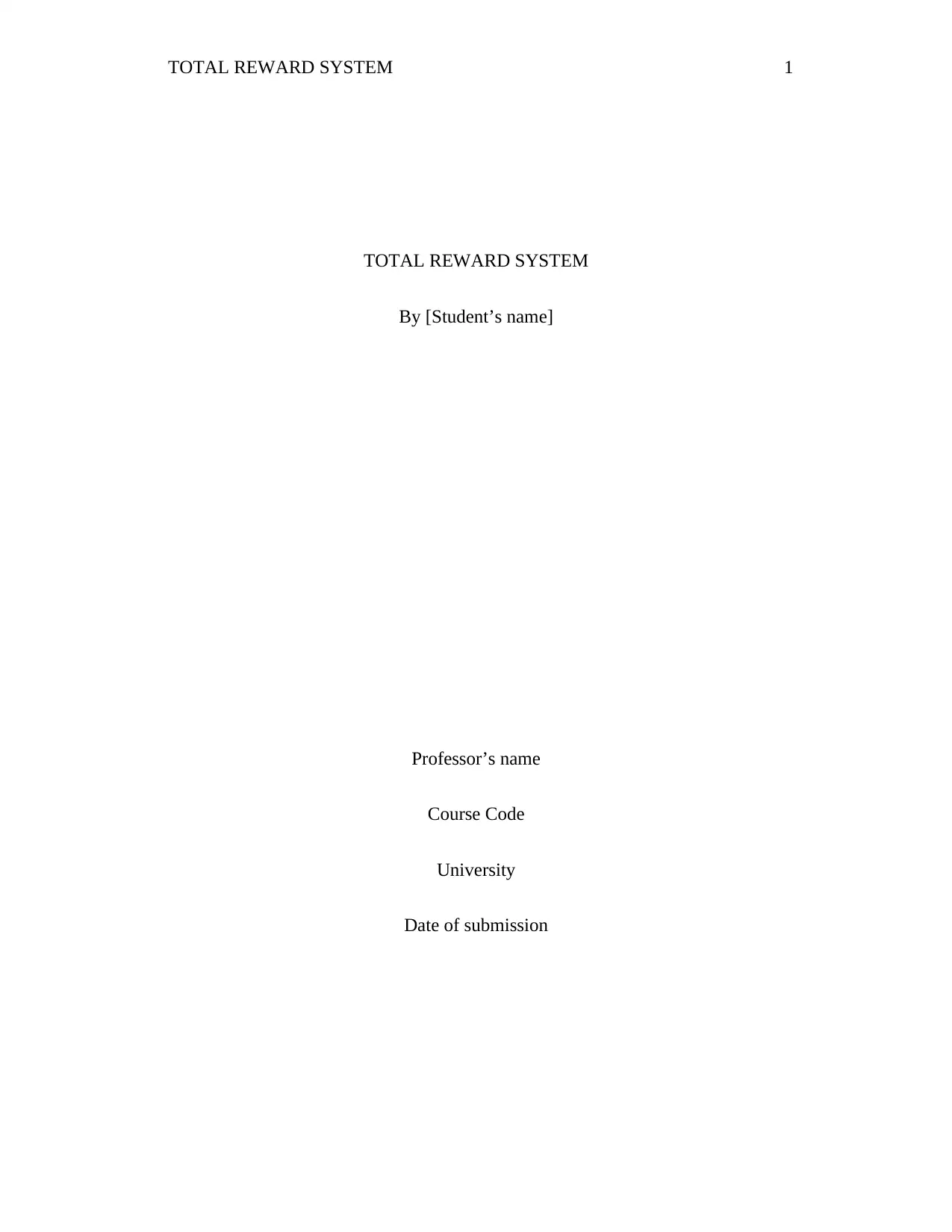
TOTAL REWARD SYSTEM 1
TOTAL REWARD SYSTEM
By [Student’s name]
Professor’s name
Course Code
University
Date of submission
TOTAL REWARD SYSTEM
By [Student’s name]
Professor’s name
Course Code
University
Date of submission
Paraphrase This Document
Need a fresh take? Get an instant paraphrase of this document with our AI Paraphraser
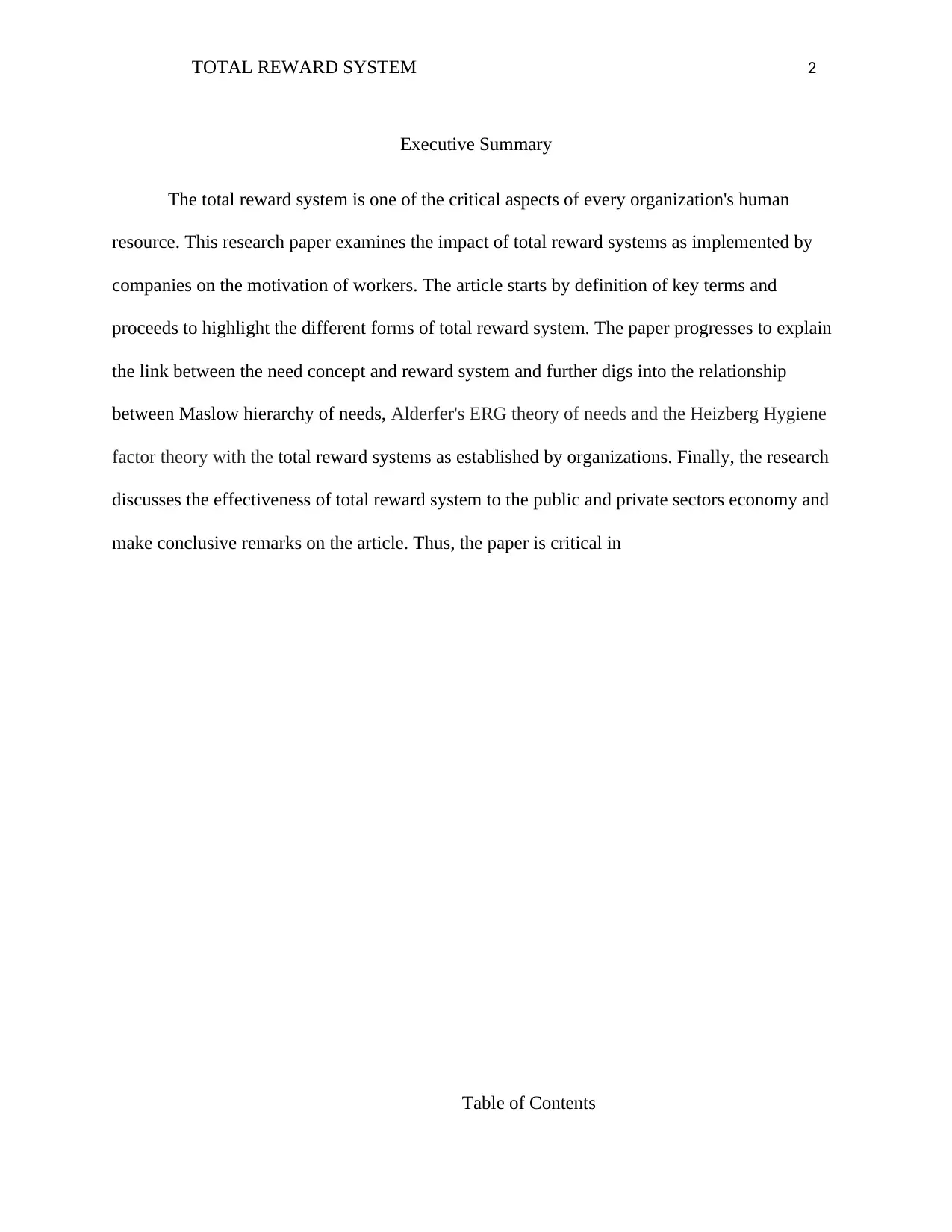
TOTAL REWARD SYSTEM 2
Executive Summary
The total reward system is one of the critical aspects of every organization's human
resource. This research paper examines the impact of total reward systems as implemented by
companies on the motivation of workers. The article starts by definition of key terms and
proceeds to highlight the different forms of total reward system. The paper progresses to explain
the link between the need concept and reward system and further digs into the relationship
between Maslow hierarchy of needs, Alderfer's ERG theory of needs and the Heizberg Hygiene
factor theory with the total reward systems as established by organizations. Finally, the research
discusses the effectiveness of total reward system to the public and private sectors economy and
make conclusive remarks on the article. Thus, the paper is critical in
Table of Contents
Executive Summary
The total reward system is one of the critical aspects of every organization's human
resource. This research paper examines the impact of total reward systems as implemented by
companies on the motivation of workers. The article starts by definition of key terms and
proceeds to highlight the different forms of total reward system. The paper progresses to explain
the link between the need concept and reward system and further digs into the relationship
between Maslow hierarchy of needs, Alderfer's ERG theory of needs and the Heizberg Hygiene
factor theory with the total reward systems as established by organizations. Finally, the research
discusses the effectiveness of total reward system to the public and private sectors economy and
make conclusive remarks on the article. Thus, the paper is critical in
Table of Contents
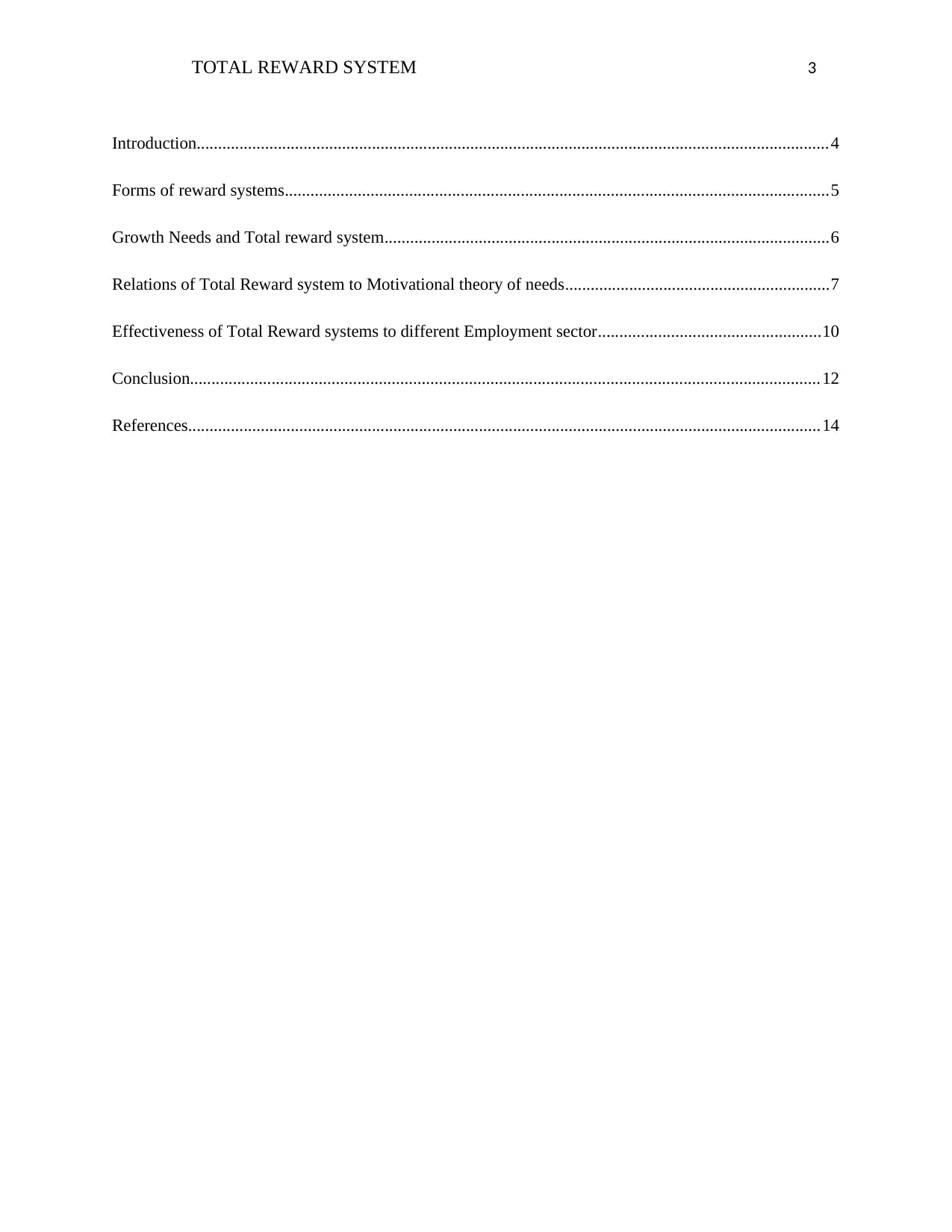
TOTAL REWARD SYSTEM 3
Introduction....................................................................................................................................................4
Forms of reward systems...............................................................................................................................5
Growth Needs and Total reward system........................................................................................................6
Relations of Total Reward system to Motivational theory of needs..............................................................7
Effectiveness of Total Reward systems to different Employment sector....................................................10
Conclusion...................................................................................................................................................12
References....................................................................................................................................................14
Introduction....................................................................................................................................................4
Forms of reward systems...............................................................................................................................5
Growth Needs and Total reward system........................................................................................................6
Relations of Total Reward system to Motivational theory of needs..............................................................7
Effectiveness of Total Reward systems to different Employment sector....................................................10
Conclusion...................................................................................................................................................12
References....................................................................................................................................................14
⊘ This is a preview!⊘
Do you want full access?
Subscribe today to unlock all pages.

Trusted by 1+ million students worldwide
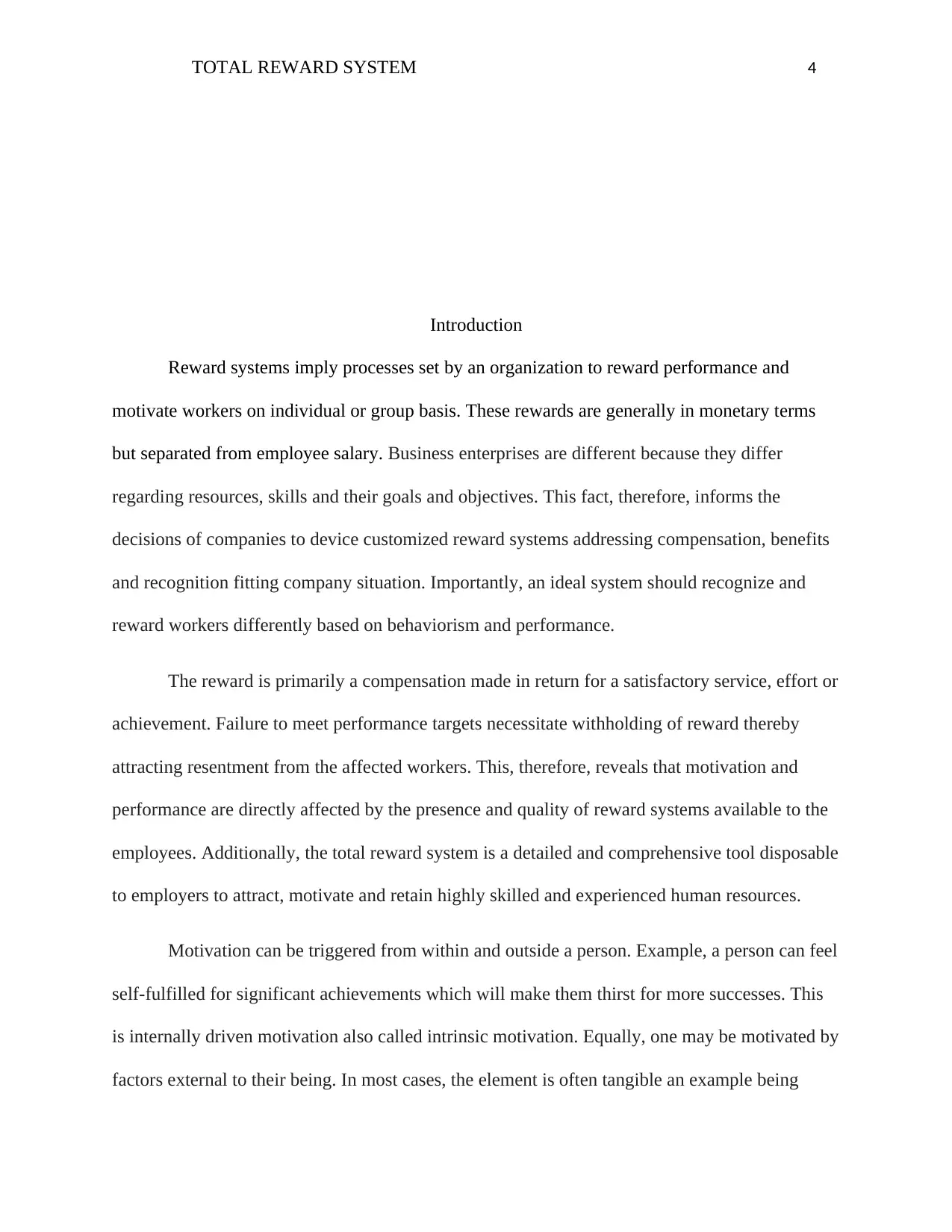
TOTAL REWARD SYSTEM 4
Introduction
Reward systems imply processes set by an organization to reward performance and
motivate workers on individual or group basis. These rewards are generally in monetary terms
but separated from employee salary. Business enterprises are different because they differ
regarding resources, skills and their goals and objectives. This fact, therefore, informs the
decisions of companies to device customized reward systems addressing compensation, benefits
and recognition fitting company situation. Importantly, an ideal system should recognize and
reward workers differently based on behaviorism and performance.
The reward is primarily a compensation made in return for a satisfactory service, effort or
achievement. Failure to meet performance targets necessitate withholding of reward thereby
attracting resentment from the affected workers. This, therefore, reveals that motivation and
performance are directly affected by the presence and quality of reward systems available to the
employees. Additionally, the total reward system is a detailed and comprehensive tool disposable
to employers to attract, motivate and retain highly skilled and experienced human resources.
Motivation can be triggered from within and outside a person. Example, a person can feel
self-fulfilled for significant achievements which will make them thirst for more successes. This
is internally driven motivation also called intrinsic motivation. Equally, one may be motivated by
factors external to their being. In most cases, the element is often tangible an example being
Introduction
Reward systems imply processes set by an organization to reward performance and
motivate workers on individual or group basis. These rewards are generally in monetary terms
but separated from employee salary. Business enterprises are different because they differ
regarding resources, skills and their goals and objectives. This fact, therefore, informs the
decisions of companies to device customized reward systems addressing compensation, benefits
and recognition fitting company situation. Importantly, an ideal system should recognize and
reward workers differently based on behaviorism and performance.
The reward is primarily a compensation made in return for a satisfactory service, effort or
achievement. Failure to meet performance targets necessitate withholding of reward thereby
attracting resentment from the affected workers. This, therefore, reveals that motivation and
performance are directly affected by the presence and quality of reward systems available to the
employees. Additionally, the total reward system is a detailed and comprehensive tool disposable
to employers to attract, motivate and retain highly skilled and experienced human resources.
Motivation can be triggered from within and outside a person. Example, a person can feel
self-fulfilled for significant achievements which will make them thirst for more successes. This
is internally driven motivation also called intrinsic motivation. Equally, one may be motivated by
factors external to their being. In most cases, the element is often tangible an example being
Paraphrase This Document
Need a fresh take? Get an instant paraphrase of this document with our AI Paraphraser
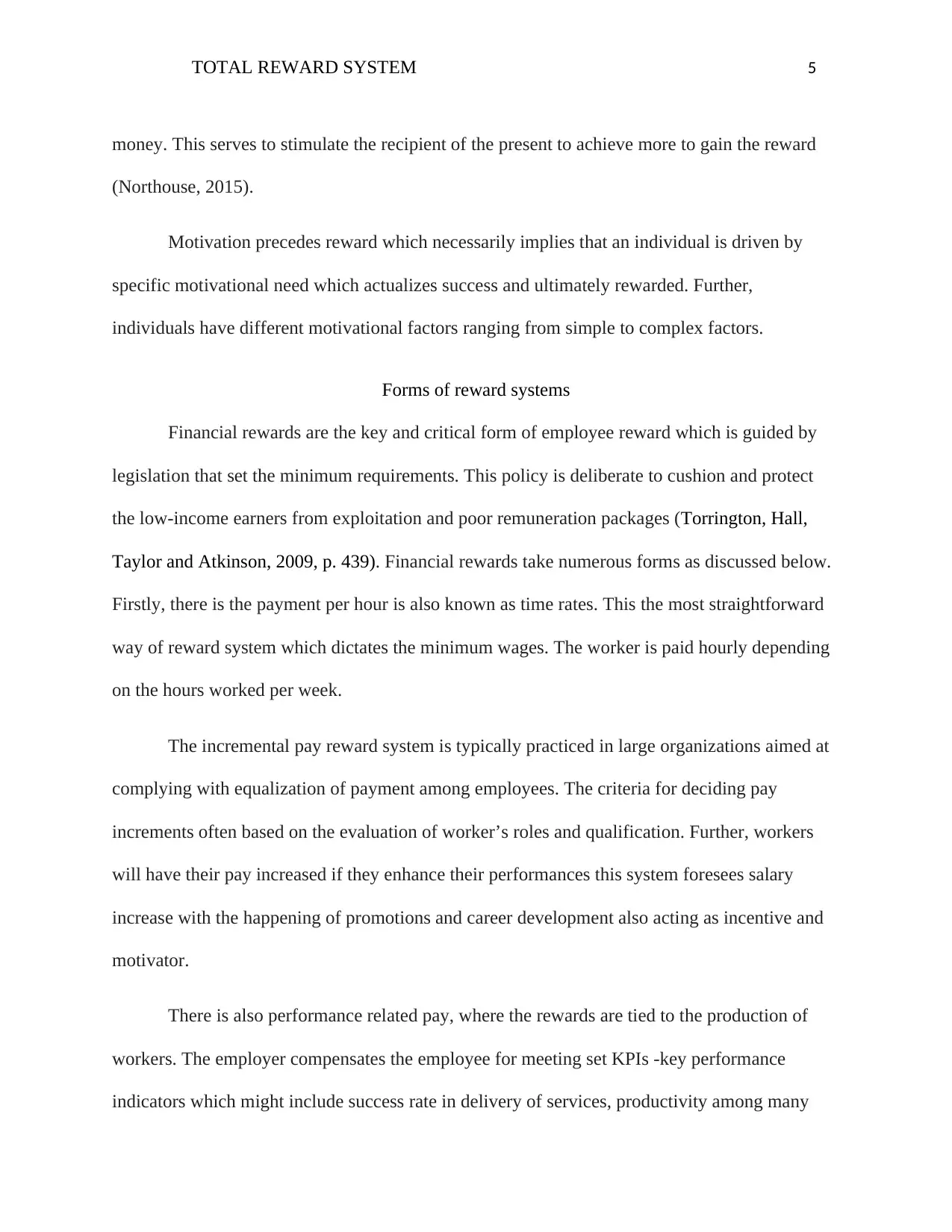
TOTAL REWARD SYSTEM 5
money. This serves to stimulate the recipient of the present to achieve more to gain the reward
(Northouse, 2015).
Motivation precedes reward which necessarily implies that an individual is driven by
specific motivational need which actualizes success and ultimately rewarded. Further,
individuals have different motivational factors ranging from simple to complex factors.
Forms of reward systems
Financial rewards are the key and critical form of employee reward which is guided by
legislation that set the minimum requirements. This policy is deliberate to cushion and protect
the low-income earners from exploitation and poor remuneration packages (Torrington, Hall,
Taylor and Atkinson, 2009, p. 439). Financial rewards take numerous forms as discussed below.
Firstly, there is the payment per hour is also known as time rates. This the most straightforward
way of reward system which dictates the minimum wages. The worker is paid hourly depending
on the hours worked per week.
The incremental pay reward system is typically practiced in large organizations aimed at
complying with equalization of payment among employees. The criteria for deciding pay
increments often based on the evaluation of worker’s roles and qualification. Further, workers
will have their pay increased if they enhance their performances this system foresees salary
increase with the happening of promotions and career development also acting as incentive and
motivator.
There is also performance related pay, where the rewards are tied to the production of
workers. The employer compensates the employee for meeting set KPIs -key performance
indicators which might include success rate in delivery of services, productivity among many
money. This serves to stimulate the recipient of the present to achieve more to gain the reward
(Northouse, 2015).
Motivation precedes reward which necessarily implies that an individual is driven by
specific motivational need which actualizes success and ultimately rewarded. Further,
individuals have different motivational factors ranging from simple to complex factors.
Forms of reward systems
Financial rewards are the key and critical form of employee reward which is guided by
legislation that set the minimum requirements. This policy is deliberate to cushion and protect
the low-income earners from exploitation and poor remuneration packages (Torrington, Hall,
Taylor and Atkinson, 2009, p. 439). Financial rewards take numerous forms as discussed below.
Firstly, there is the payment per hour is also known as time rates. This the most straightforward
way of reward system which dictates the minimum wages. The worker is paid hourly depending
on the hours worked per week.
The incremental pay reward system is typically practiced in large organizations aimed at
complying with equalization of payment among employees. The criteria for deciding pay
increments often based on the evaluation of worker’s roles and qualification. Further, workers
will have their pay increased if they enhance their performances this system foresees salary
increase with the happening of promotions and career development also acting as incentive and
motivator.
There is also performance related pay, where the rewards are tied to the production of
workers. The employer compensates the employee for meeting set KPIs -key performance
indicators which might include success rate in delivery of services, productivity among many
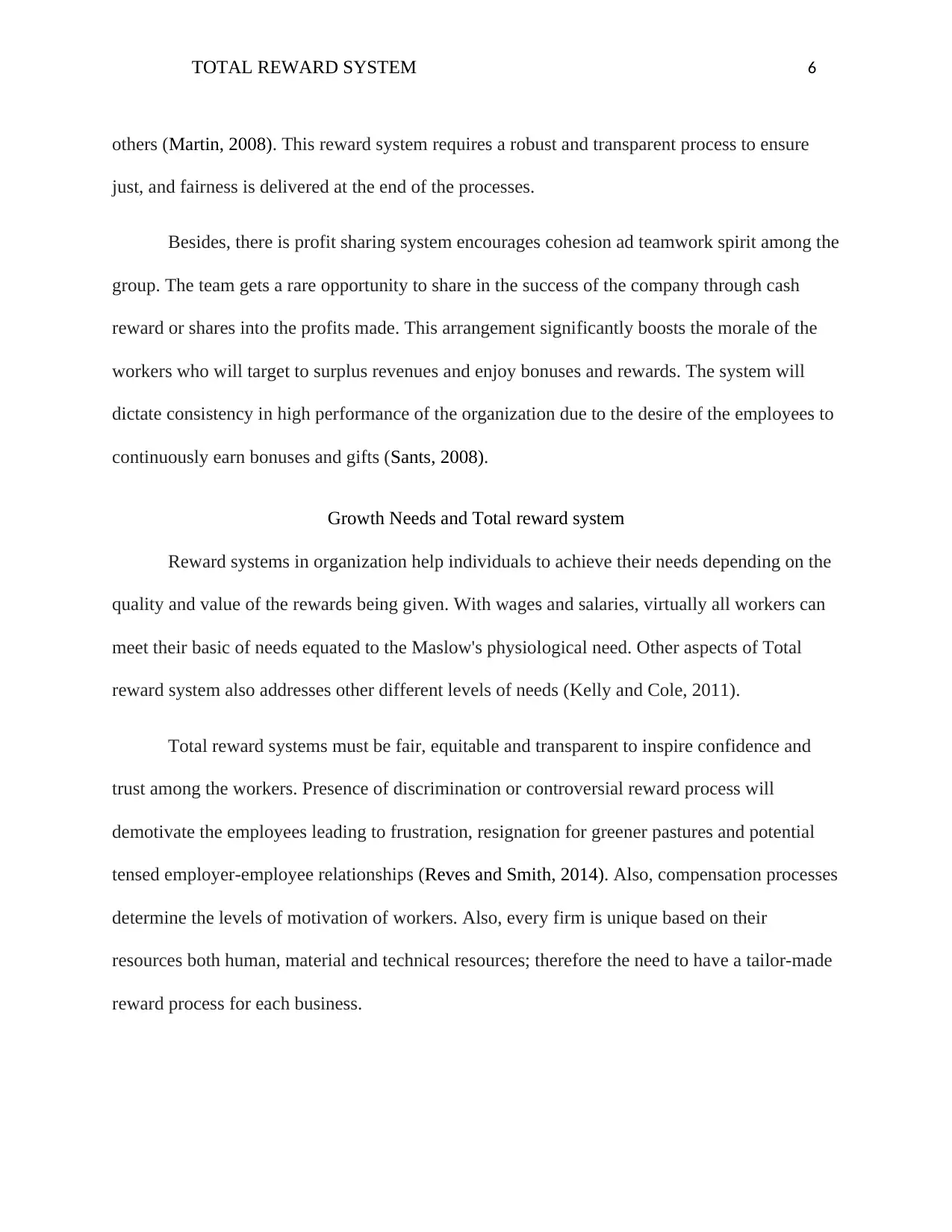
TOTAL REWARD SYSTEM 6
others (Martin, 2008). This reward system requires a robust and transparent process to ensure
just, and fairness is delivered at the end of the processes.
Besides, there is profit sharing system encourages cohesion ad teamwork spirit among the
group. The team gets a rare opportunity to share in the success of the company through cash
reward or shares into the profits made. This arrangement significantly boosts the morale of the
workers who will target to surplus revenues and enjoy bonuses and rewards. The system will
dictate consistency in high performance of the organization due to the desire of the employees to
continuously earn bonuses and gifts (Sants, 2008).
Growth Needs and Total reward system
Reward systems in organization help individuals to achieve their needs depending on the
quality and value of the rewards being given. With wages and salaries, virtually all workers can
meet their basic of needs equated to the Maslow's physiological need. Other aspects of Total
reward system also addresses other different levels of needs (Kelly and Cole, 2011).
Total reward systems must be fair, equitable and transparent to inspire confidence and
trust among the workers. Presence of discrimination or controversial reward process will
demotivate the employees leading to frustration, resignation for greener pastures and potential
tensed employer-employee relationships (Reves and Smith, 2014). Also, compensation processes
determine the levels of motivation of workers. Also, every firm is unique based on their
resources both human, material and technical resources; therefore the need to have a tailor-made
reward process for each business.
others (Martin, 2008). This reward system requires a robust and transparent process to ensure
just, and fairness is delivered at the end of the processes.
Besides, there is profit sharing system encourages cohesion ad teamwork spirit among the
group. The team gets a rare opportunity to share in the success of the company through cash
reward or shares into the profits made. This arrangement significantly boosts the morale of the
workers who will target to surplus revenues and enjoy bonuses and rewards. The system will
dictate consistency in high performance of the organization due to the desire of the employees to
continuously earn bonuses and gifts (Sants, 2008).
Growth Needs and Total reward system
Reward systems in organization help individuals to achieve their needs depending on the
quality and value of the rewards being given. With wages and salaries, virtually all workers can
meet their basic of needs equated to the Maslow's physiological need. Other aspects of Total
reward system also addresses other different levels of needs (Kelly and Cole, 2011).
Total reward systems must be fair, equitable and transparent to inspire confidence and
trust among the workers. Presence of discrimination or controversial reward process will
demotivate the employees leading to frustration, resignation for greener pastures and potential
tensed employer-employee relationships (Reves and Smith, 2014). Also, compensation processes
determine the levels of motivation of workers. Also, every firm is unique based on their
resources both human, material and technical resources; therefore the need to have a tailor-made
reward process for each business.
⊘ This is a preview!⊘
Do you want full access?
Subscribe today to unlock all pages.

Trusted by 1+ million students worldwide
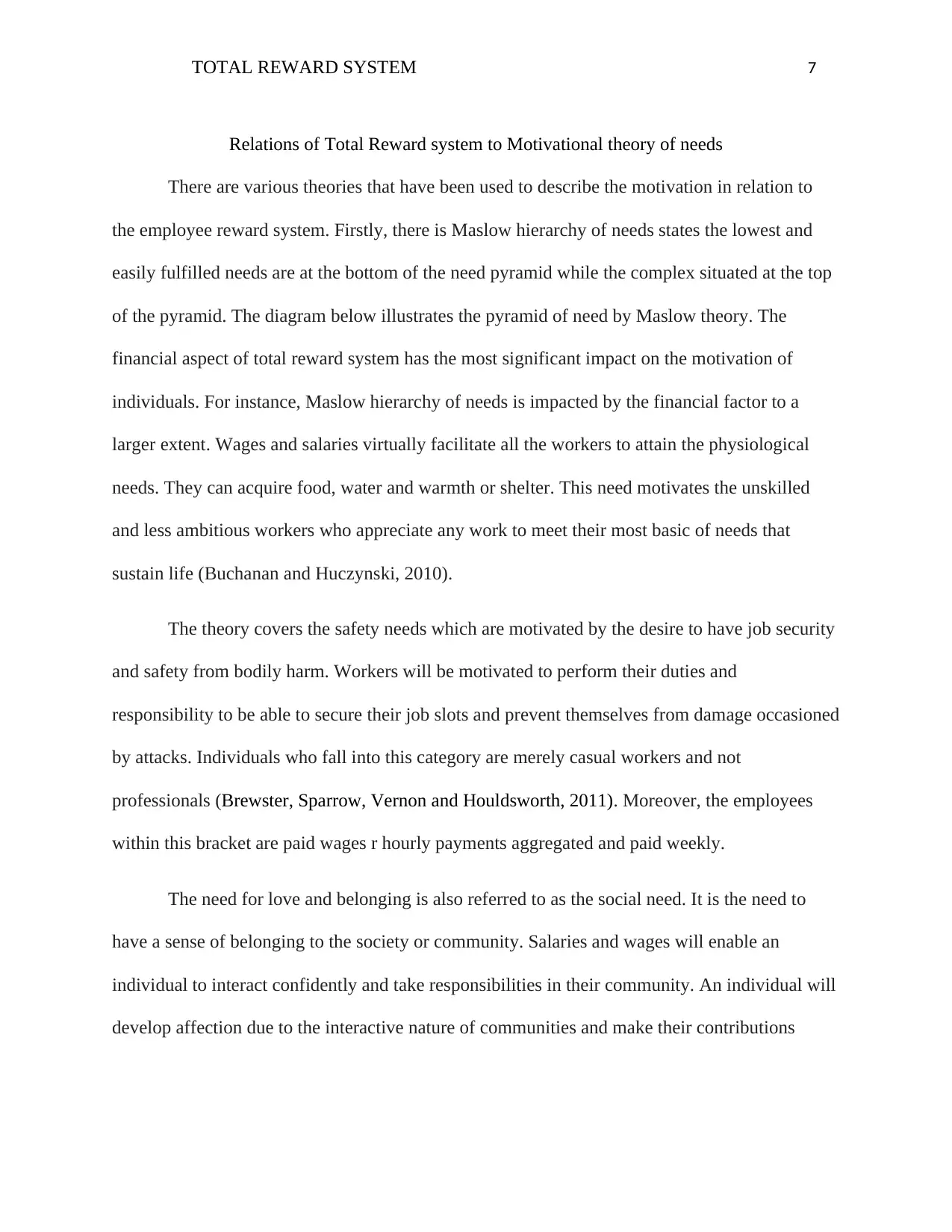
TOTAL REWARD SYSTEM 7
Relations of Total Reward system to Motivational theory of needs
There are various theories that have been used to describe the motivation in relation to
the employee reward system. Firstly, there is Maslow hierarchy of needs states the lowest and
easily fulfilled needs are at the bottom of the need pyramid while the complex situated at the top
of the pyramid. The diagram below illustrates the pyramid of need by Maslow theory. The
financial aspect of total reward system has the most significant impact on the motivation of
individuals. For instance, Maslow hierarchy of needs is impacted by the financial factor to a
larger extent. Wages and salaries virtually facilitate all the workers to attain the physiological
needs. They can acquire food, water and warmth or shelter. This need motivates the unskilled
and less ambitious workers who appreciate any work to meet their most basic of needs that
sustain life (Buchanan and Huczynski, 2010).
The theory covers the safety needs which are motivated by the desire to have job security
and safety from bodily harm. Workers will be motivated to perform their duties and
responsibility to be able to secure their job slots and prevent themselves from damage occasioned
by attacks. Individuals who fall into this category are merely casual workers and not
professionals (Brewster, Sparrow, Vernon and Houldsworth, 2011). Moreover, the employees
within this bracket are paid wages r hourly payments aggregated and paid weekly.
The need for love and belonging is also referred to as the social need. It is the need to
have a sense of belonging to the society or community. Salaries and wages will enable an
individual to interact confidently and take responsibilities in their community. An individual will
develop affection due to the interactive nature of communities and make their contributions
Relations of Total Reward system to Motivational theory of needs
There are various theories that have been used to describe the motivation in relation to
the employee reward system. Firstly, there is Maslow hierarchy of needs states the lowest and
easily fulfilled needs are at the bottom of the need pyramid while the complex situated at the top
of the pyramid. The diagram below illustrates the pyramid of need by Maslow theory. The
financial aspect of total reward system has the most significant impact on the motivation of
individuals. For instance, Maslow hierarchy of needs is impacted by the financial factor to a
larger extent. Wages and salaries virtually facilitate all the workers to attain the physiological
needs. They can acquire food, water and warmth or shelter. This need motivates the unskilled
and less ambitious workers who appreciate any work to meet their most basic of needs that
sustain life (Buchanan and Huczynski, 2010).
The theory covers the safety needs which are motivated by the desire to have job security
and safety from bodily harm. Workers will be motivated to perform their duties and
responsibility to be able to secure their job slots and prevent themselves from damage occasioned
by attacks. Individuals who fall into this category are merely casual workers and not
professionals (Brewster, Sparrow, Vernon and Houldsworth, 2011). Moreover, the employees
within this bracket are paid wages r hourly payments aggregated and paid weekly.
The need for love and belonging is also referred to as the social need. It is the need to
have a sense of belonging to the society or community. Salaries and wages will enable an
individual to interact confidently and take responsibilities in their community. An individual will
develop affection due to the interactive nature of communities and make their contributions
Paraphrase This Document
Need a fresh take? Get an instant paraphrase of this document with our AI Paraphraser
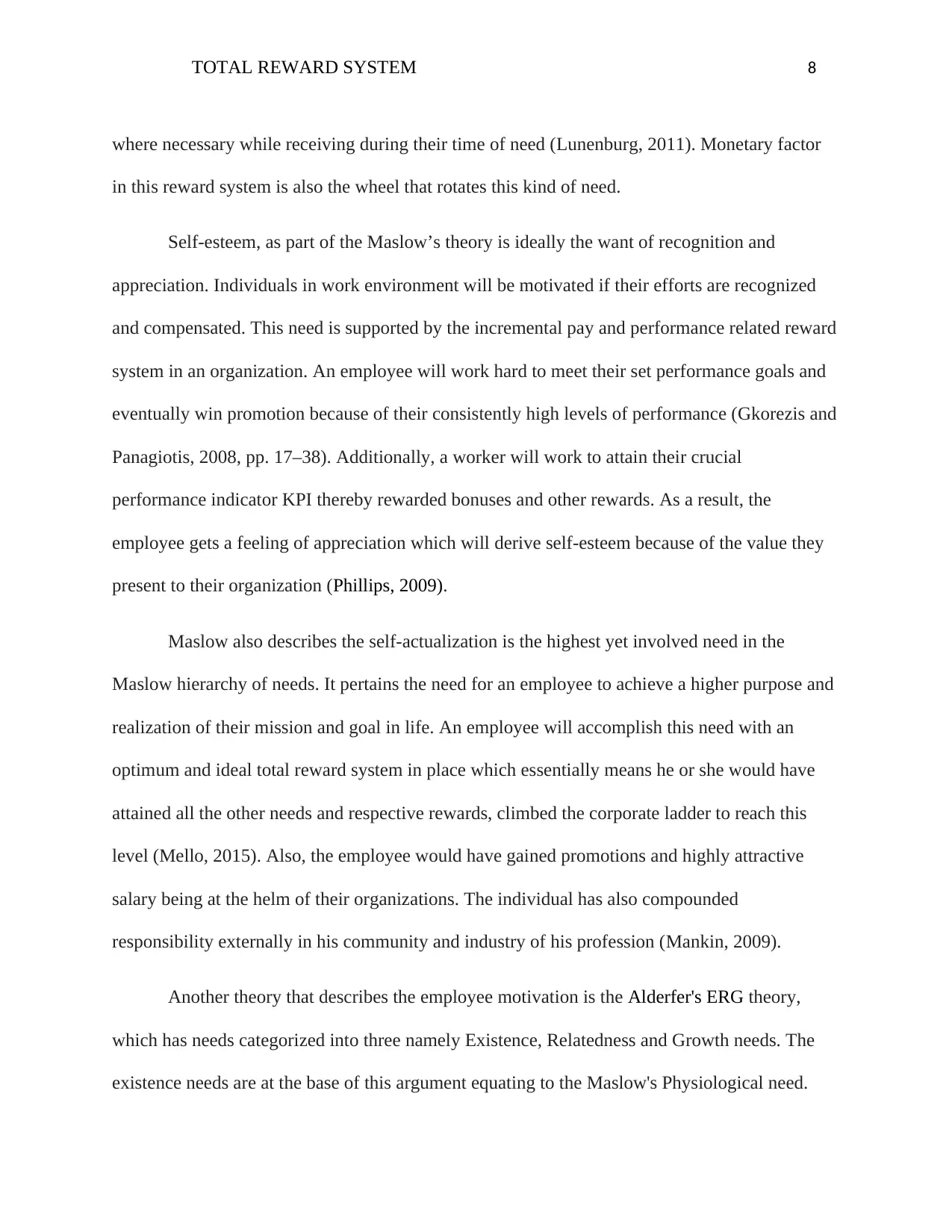
TOTAL REWARD SYSTEM 8
where necessary while receiving during their time of need (Lunenburg, 2011). Monetary factor
in this reward system is also the wheel that rotates this kind of need.
Self-esteem, as part of the Maslow’s theory is ideally the want of recognition and
appreciation. Individuals in work environment will be motivated if their efforts are recognized
and compensated. This need is supported by the incremental pay and performance related reward
system in an organization. An employee will work hard to meet their set performance goals and
eventually win promotion because of their consistently high levels of performance (Gkorezis and
Panagiotis, 2008, pp. 17–38). Additionally, a worker will work to attain their crucial
performance indicator KPI thereby rewarded bonuses and other rewards. As a result, the
employee gets a feeling of appreciation which will derive self-esteem because of the value they
present to their organization (Phillips, 2009).
Maslow also describes the self-actualization is the highest yet involved need in the
Maslow hierarchy of needs. It pertains the need for an employee to achieve a higher purpose and
realization of their mission and goal in life. An employee will accomplish this need with an
optimum and ideal total reward system in place which essentially means he or she would have
attained all the other needs and respective rewards, climbed the corporate ladder to reach this
level (Mello, 2015). Also, the employee would have gained promotions and highly attractive
salary being at the helm of their organizations. The individual has also compounded
responsibility externally in his community and industry of his profession (Mankin, 2009).
Another theory that describes the employee motivation is the Alderfer's ERG theory,
which has needs categorized into three namely Existence, Relatedness and Growth needs. The
existence needs are at the base of this argument equating to the Maslow's Physiological need.
where necessary while receiving during their time of need (Lunenburg, 2011). Monetary factor
in this reward system is also the wheel that rotates this kind of need.
Self-esteem, as part of the Maslow’s theory is ideally the want of recognition and
appreciation. Individuals in work environment will be motivated if their efforts are recognized
and compensated. This need is supported by the incremental pay and performance related reward
system in an organization. An employee will work hard to meet their set performance goals and
eventually win promotion because of their consistently high levels of performance (Gkorezis and
Panagiotis, 2008, pp. 17–38). Additionally, a worker will work to attain their crucial
performance indicator KPI thereby rewarded bonuses and other rewards. As a result, the
employee gets a feeling of appreciation which will derive self-esteem because of the value they
present to their organization (Phillips, 2009).
Maslow also describes the self-actualization is the highest yet involved need in the
Maslow hierarchy of needs. It pertains the need for an employee to achieve a higher purpose and
realization of their mission and goal in life. An employee will accomplish this need with an
optimum and ideal total reward system in place which essentially means he or she would have
attained all the other needs and respective rewards, climbed the corporate ladder to reach this
level (Mello, 2015). Also, the employee would have gained promotions and highly attractive
salary being at the helm of their organizations. The individual has also compounded
responsibility externally in his community and industry of his profession (Mankin, 2009).
Another theory that describes the employee motivation is the Alderfer's ERG theory,
which has needs categorized into three namely Existence, Relatedness and Growth needs. The
existence needs are at the base of this argument equating to the Maslow's Physiological need.
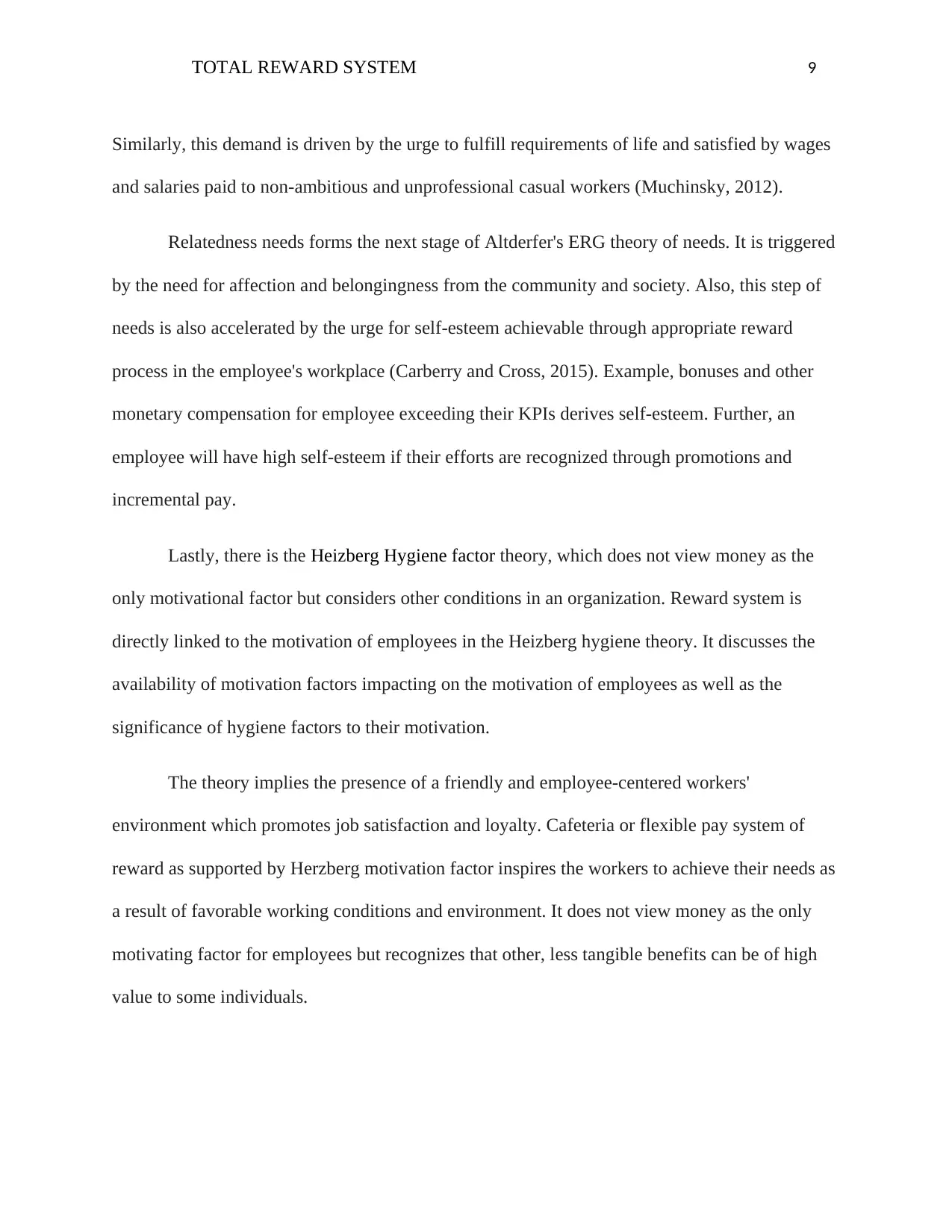
TOTAL REWARD SYSTEM 9
Similarly, this demand is driven by the urge to fulfill requirements of life and satisfied by wages
and salaries paid to non-ambitious and unprofessional casual workers (Muchinsky, 2012).
Relatedness needs forms the next stage of Altderfer's ERG theory of needs. It is triggered
by the need for affection and belongingness from the community and society. Also, this step of
needs is also accelerated by the urge for self-esteem achievable through appropriate reward
process in the employee's workplace (Carberry and Cross, 2015). Example, bonuses and other
monetary compensation for employee exceeding their KPIs derives self-esteem. Further, an
employee will have high self-esteem if their efforts are recognized through promotions and
incremental pay.
Lastly, there is the Heizberg Hygiene factor theory, which does not view money as the
only motivational factor but considers other conditions in an organization. Reward system is
directly linked to the motivation of employees in the Heizberg hygiene theory. It discusses the
availability of motivation factors impacting on the motivation of employees as well as the
significance of hygiene factors to their motivation.
The theory implies the presence of a friendly and employee-centered workers'
environment which promotes job satisfaction and loyalty. Cafeteria or flexible pay system of
reward as supported by Herzberg motivation factor inspires the workers to achieve their needs as
a result of favorable working conditions and environment. It does not view money as the only
motivating factor for employees but recognizes that other, less tangible benefits can be of high
value to some individuals.
Similarly, this demand is driven by the urge to fulfill requirements of life and satisfied by wages
and salaries paid to non-ambitious and unprofessional casual workers (Muchinsky, 2012).
Relatedness needs forms the next stage of Altderfer's ERG theory of needs. It is triggered
by the need for affection and belongingness from the community and society. Also, this step of
needs is also accelerated by the urge for self-esteem achievable through appropriate reward
process in the employee's workplace (Carberry and Cross, 2015). Example, bonuses and other
monetary compensation for employee exceeding their KPIs derives self-esteem. Further, an
employee will have high self-esteem if their efforts are recognized through promotions and
incremental pay.
Lastly, there is the Heizberg Hygiene factor theory, which does not view money as the
only motivational factor but considers other conditions in an organization. Reward system is
directly linked to the motivation of employees in the Heizberg hygiene theory. It discusses the
availability of motivation factors impacting on the motivation of employees as well as the
significance of hygiene factors to their motivation.
The theory implies the presence of a friendly and employee-centered workers'
environment which promotes job satisfaction and loyalty. Cafeteria or flexible pay system of
reward as supported by Herzberg motivation factor inspires the workers to achieve their needs as
a result of favorable working conditions and environment. It does not view money as the only
motivating factor for employees but recognizes that other, less tangible benefits can be of high
value to some individuals.
⊘ This is a preview!⊘
Do you want full access?
Subscribe today to unlock all pages.

Trusted by 1+ million students worldwide
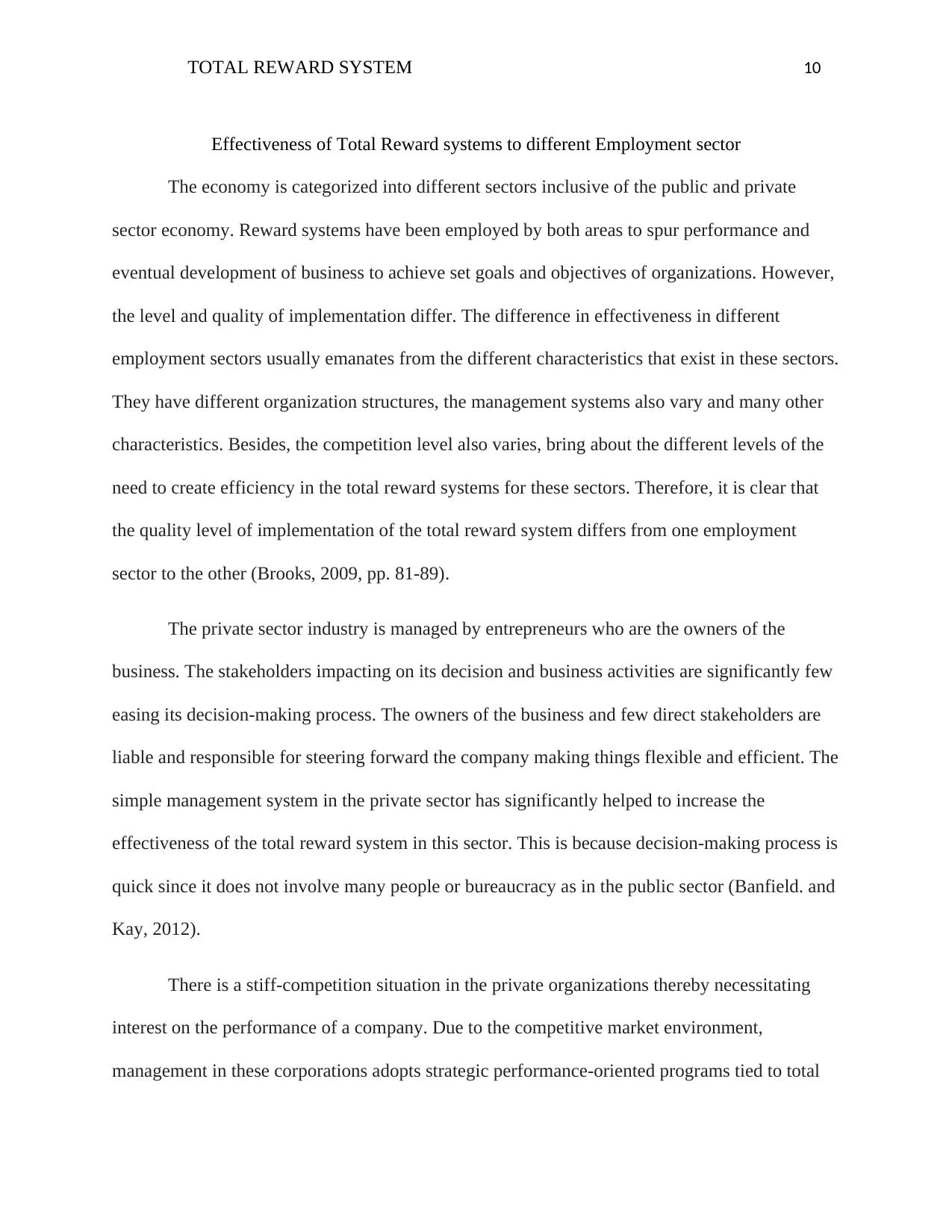
TOTAL REWARD SYSTEM 10
Effectiveness of Total Reward systems to different Employment sector
The economy is categorized into different sectors inclusive of the public and private
sector economy. Reward systems have been employed by both areas to spur performance and
eventual development of business to achieve set goals and objectives of organizations. However,
the level and quality of implementation differ. The difference in effectiveness in different
employment sectors usually emanates from the different characteristics that exist in these sectors.
They have different organization structures, the management systems also vary and many other
characteristics. Besides, the competition level also varies, bring about the different levels of the
need to create efficiency in the total reward systems for these sectors. Therefore, it is clear that
the quality level of implementation of the total reward system differs from one employment
sector to the other (Brooks, 2009, pp. 81-89).
The private sector industry is managed by entrepreneurs who are the owners of the
business. The stakeholders impacting on its decision and business activities are significantly few
easing its decision-making process. The owners of the business and few direct stakeholders are
liable and responsible for steering forward the company making things flexible and efficient. The
simple management system in the private sector has significantly helped to increase the
effectiveness of the total reward system in this sector. This is because decision-making process is
quick since it does not involve many people or bureaucracy as in the public sector (Banfield. and
Kay, 2012).
There is a stiff-competition situation in the private organizations thereby necessitating
interest on the performance of a company. Due to the competitive market environment,
management in these corporations adopts strategic performance-oriented programs tied to total
Effectiveness of Total Reward systems to different Employment sector
The economy is categorized into different sectors inclusive of the public and private
sector economy. Reward systems have been employed by both areas to spur performance and
eventual development of business to achieve set goals and objectives of organizations. However,
the level and quality of implementation differ. The difference in effectiveness in different
employment sectors usually emanates from the different characteristics that exist in these sectors.
They have different organization structures, the management systems also vary and many other
characteristics. Besides, the competition level also varies, bring about the different levels of the
need to create efficiency in the total reward systems for these sectors. Therefore, it is clear that
the quality level of implementation of the total reward system differs from one employment
sector to the other (Brooks, 2009, pp. 81-89).
The private sector industry is managed by entrepreneurs who are the owners of the
business. The stakeholders impacting on its decision and business activities are significantly few
easing its decision-making process. The owners of the business and few direct stakeholders are
liable and responsible for steering forward the company making things flexible and efficient. The
simple management system in the private sector has significantly helped to increase the
effectiveness of the total reward system in this sector. This is because decision-making process is
quick since it does not involve many people or bureaucracy as in the public sector (Banfield. and
Kay, 2012).
There is a stiff-competition situation in the private organizations thereby necessitating
interest on the performance of a company. Due to the competitive market environment,
management in these corporations adopts strategic performance-oriented programs tied to total
Paraphrase This Document
Need a fresh take? Get an instant paraphrase of this document with our AI Paraphraser
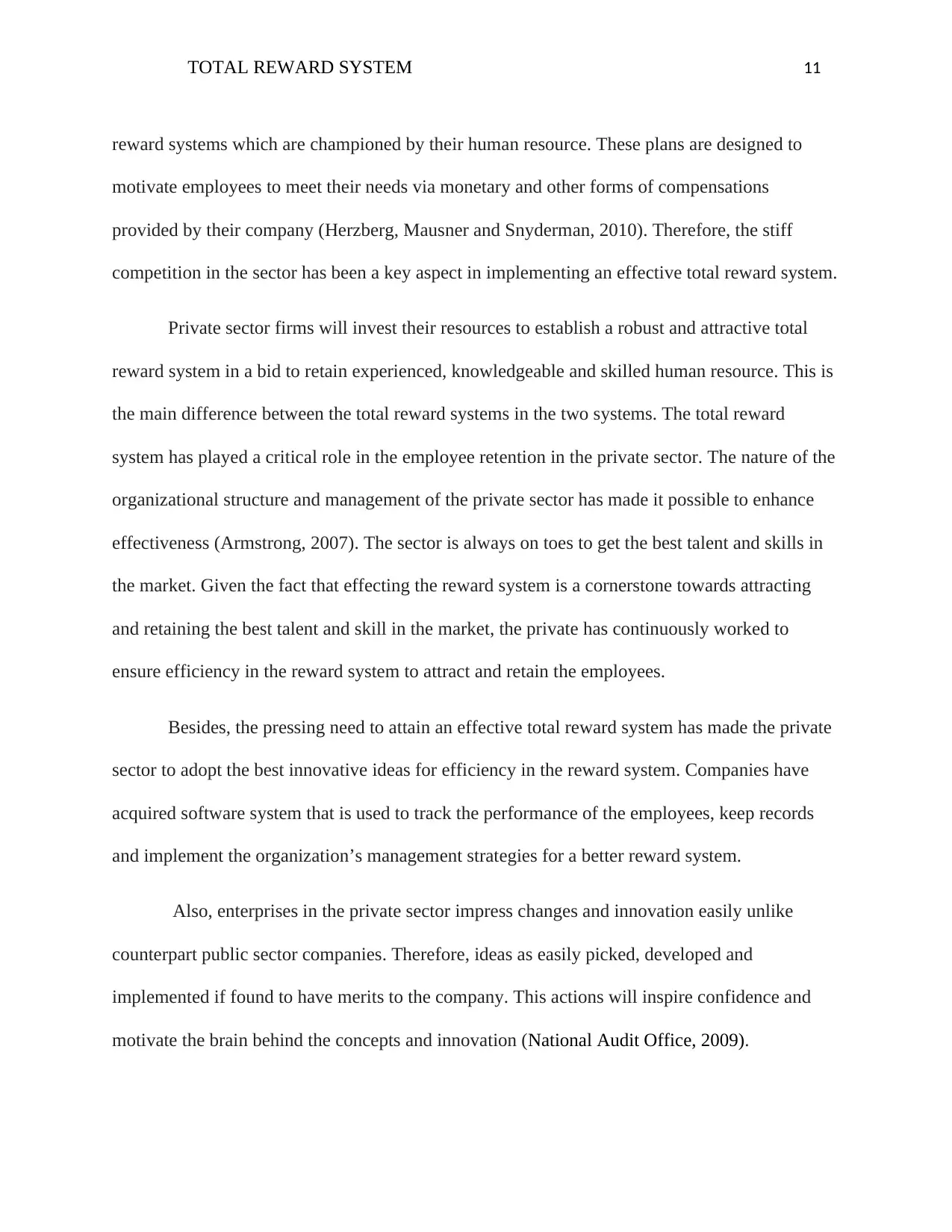
TOTAL REWARD SYSTEM 11
reward systems which are championed by their human resource. These plans are designed to
motivate employees to meet their needs via monetary and other forms of compensations
provided by their company (Herzberg, Mausner and Snyderman, 2010). Therefore, the stiff
competition in the sector has been a key aspect in implementing an effective total reward system.
Private sector firms will invest their resources to establish a robust and attractive total
reward system in a bid to retain experienced, knowledgeable and skilled human resource. This is
the main difference between the total reward systems in the two systems. The total reward
system has played a critical role in the employee retention in the private sector. The nature of the
organizational structure and management of the private sector has made it possible to enhance
effectiveness (Armstrong, 2007). The sector is always on toes to get the best talent and skills in
the market. Given the fact that effecting the reward system is a cornerstone towards attracting
and retaining the best talent and skill in the market, the private has continuously worked to
ensure efficiency in the reward system to attract and retain the employees.
Besides, the pressing need to attain an effective total reward system has made the private
sector to adopt the best innovative ideas for efficiency in the reward system. Companies have
acquired software system that is used to track the performance of the employees, keep records
and implement the organization’s management strategies for a better reward system.
Also, enterprises in the private sector impress changes and innovation easily unlike
counterpart public sector companies. Therefore, ideas as easily picked, developed and
implemented if found to have merits to the company. This actions will inspire confidence and
motivate the brain behind the concepts and innovation (National Audit Office, 2009).
reward systems which are championed by their human resource. These plans are designed to
motivate employees to meet their needs via monetary and other forms of compensations
provided by their company (Herzberg, Mausner and Snyderman, 2010). Therefore, the stiff
competition in the sector has been a key aspect in implementing an effective total reward system.
Private sector firms will invest their resources to establish a robust and attractive total
reward system in a bid to retain experienced, knowledgeable and skilled human resource. This is
the main difference between the total reward systems in the two systems. The total reward
system has played a critical role in the employee retention in the private sector. The nature of the
organizational structure and management of the private sector has made it possible to enhance
effectiveness (Armstrong, 2007). The sector is always on toes to get the best talent and skills in
the market. Given the fact that effecting the reward system is a cornerstone towards attracting
and retaining the best talent and skill in the market, the private has continuously worked to
ensure efficiency in the reward system to attract and retain the employees.
Besides, the pressing need to attain an effective total reward system has made the private
sector to adopt the best innovative ideas for efficiency in the reward system. Companies have
acquired software system that is used to track the performance of the employees, keep records
and implement the organization’s management strategies for a better reward system.
Also, enterprises in the private sector impress changes and innovation easily unlike
counterpart public sector companies. Therefore, ideas as easily picked, developed and
implemented if found to have merits to the company. This actions will inspire confidence and
motivate the brain behind the concepts and innovation (National Audit Office, 2009).
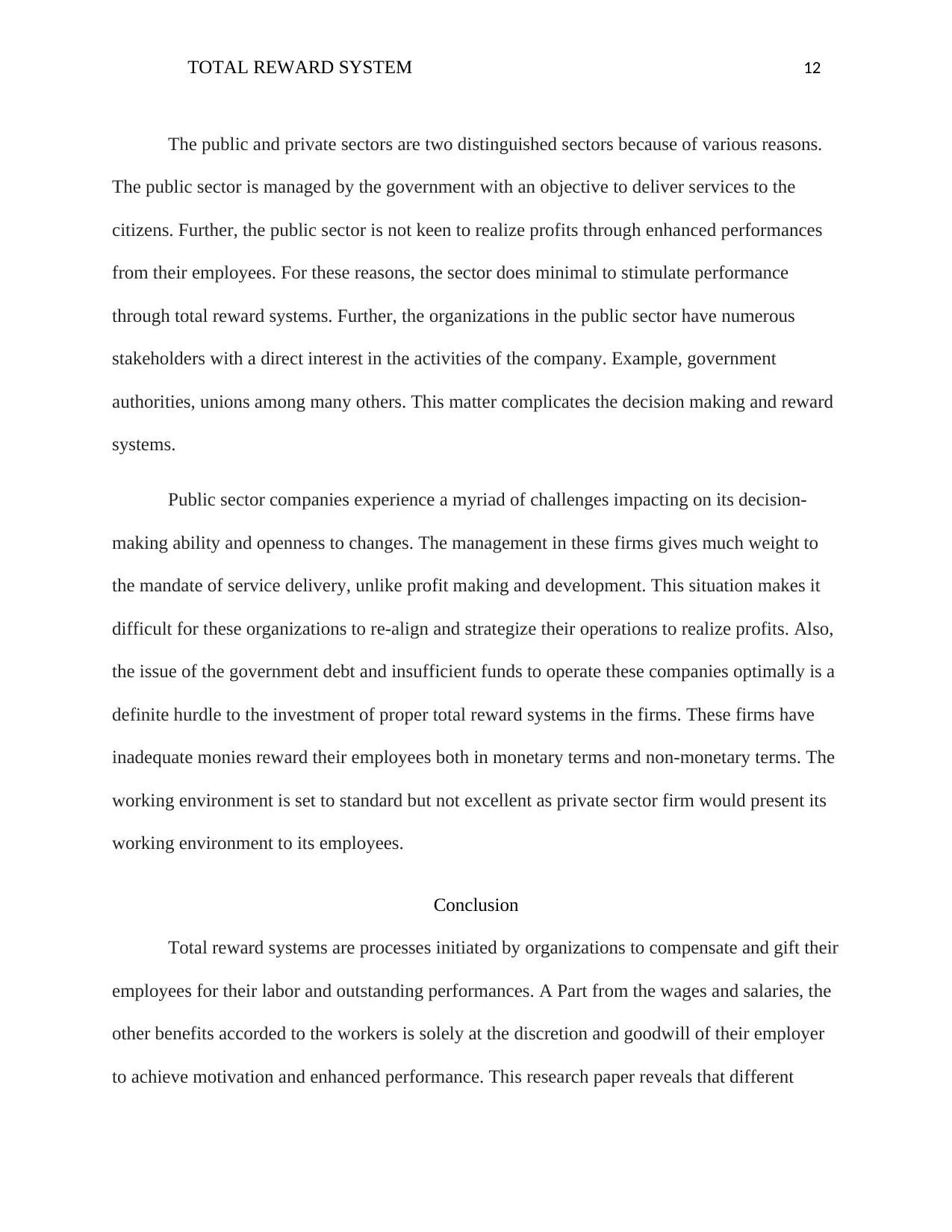
TOTAL REWARD SYSTEM 12
The public and private sectors are two distinguished sectors because of various reasons.
The public sector is managed by the government with an objective to deliver services to the
citizens. Further, the public sector is not keen to realize profits through enhanced performances
from their employees. For these reasons, the sector does minimal to stimulate performance
through total reward systems. Further, the organizations in the public sector have numerous
stakeholders with a direct interest in the activities of the company. Example, government
authorities, unions among many others. This matter complicates the decision making and reward
systems.
Public sector companies experience a myriad of challenges impacting on its decision-
making ability and openness to changes. The management in these firms gives much weight to
the mandate of service delivery, unlike profit making and development. This situation makes it
difficult for these organizations to re-align and strategize their operations to realize profits. Also,
the issue of the government debt and insufficient funds to operate these companies optimally is a
definite hurdle to the investment of proper total reward systems in the firms. These firms have
inadequate monies reward their employees both in monetary terms and non-monetary terms. The
working environment is set to standard but not excellent as private sector firm would present its
working environment to its employees.
Conclusion
Total reward systems are processes initiated by organizations to compensate and gift their
employees for their labor and outstanding performances. A Part from the wages and salaries, the
other benefits accorded to the workers is solely at the discretion and goodwill of their employer
to achieve motivation and enhanced performance. This research paper reveals that different
The public and private sectors are two distinguished sectors because of various reasons.
The public sector is managed by the government with an objective to deliver services to the
citizens. Further, the public sector is not keen to realize profits through enhanced performances
from their employees. For these reasons, the sector does minimal to stimulate performance
through total reward systems. Further, the organizations in the public sector have numerous
stakeholders with a direct interest in the activities of the company. Example, government
authorities, unions among many others. This matter complicates the decision making and reward
systems.
Public sector companies experience a myriad of challenges impacting on its decision-
making ability and openness to changes. The management in these firms gives much weight to
the mandate of service delivery, unlike profit making and development. This situation makes it
difficult for these organizations to re-align and strategize their operations to realize profits. Also,
the issue of the government debt and insufficient funds to operate these companies optimally is a
definite hurdle to the investment of proper total reward systems in the firms. These firms have
inadequate monies reward their employees both in monetary terms and non-monetary terms. The
working environment is set to standard but not excellent as private sector firm would present its
working environment to its employees.
Conclusion
Total reward systems are processes initiated by organizations to compensate and gift their
employees for their labor and outstanding performances. A Part from the wages and salaries, the
other benefits accorded to the workers is solely at the discretion and goodwill of their employer
to achieve motivation and enhanced performance. This research paper reveals that different
⊘ This is a preview!⊘
Do you want full access?
Subscribe today to unlock all pages.

Trusted by 1+ million students worldwide
1 out of 16
Related Documents
Your All-in-One AI-Powered Toolkit for Academic Success.
+13062052269
info@desklib.com
Available 24*7 on WhatsApp / Email
![[object Object]](/_next/static/media/star-bottom.7253800d.svg)
Unlock your academic potential
Copyright © 2020–2025 A2Z Services. All Rights Reserved. Developed and managed by ZUCOL.





